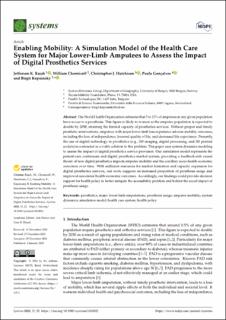| dc.contributor.author | Rajah, Jefferson Karthikeyan | |
| dc.contributor.author | Chernicoff, William | |
| dc.contributor.author | Hutchison, Christopher J. | |
| dc.contributor.author | Paulo, Gonçalves | |
| dc.contributor.author | Kopainsky, Birgit | |
| dc.date.accessioned | 2023-02-08T14:01:51Z | |
| dc.date.available | 2023-02-08T14:01:51Z | |
| dc.date.created | 2023-01-23T11:13:18Z | |
| dc.date.issued | 2023 | |
| dc.identifier.issn | 2079-8954 | |
| dc.identifier.uri | https://hdl.handle.net/11250/3049394 | |
| dc.description.abstract | The World Health Organization estimates that 5 to 15% of amputees in any given population have access to a prosthesis. This figure is likely to worsen as the amputee population is expected to double by 2050, straining the limited capacity of prosthetics services. Without proper and timely prosthetic interventions, amputees with major lower-limb loss experience adverse mobility outcomes, including the loss of independence, lowered quality of life, and decreased life expectancy. Presently, the use of digital technology in prosthetics (e.g., 3D imaging, digital processing, and 3D printed sockets) is contended as a viable solution to this problem. This paper uses system dynamics modeling to assess the impact of digital prosthetics service provision. Our simulation model represents the patient-care continuum and digital prosthetics market system, providing a feedback-rich causal theory of how digital prosthetics impacts amputee mobility and the corollary socio-health-economic outcomes over time. With sufficient resources for market formation and capacity expansion for digital prosthetics services, our work suggests an increased proportion of prosthesis usage and improved associated health-economic outcomes. Accordingly, our findings could provide decision support for health policy to better mitigate the accessibility problem and bolster the social impact of prosthesis usage. | en_US |
| dc.language.iso | eng | en_US |
| dc.publisher | MDPI | en_US |
| dc.rights | Navngivelse 4.0 Internasjonal | * |
| dc.rights.uri | http://creativecommons.org/licenses/by/4.0/deed.no | * |
| dc.title | Enabling Mobility: A Simulation Model of the Health Care System for Major Lower-Limb Amputees to Assess the Impact of Digital Prosthetics Services | en_US |
| dc.type | Journal article | en_US |
| dc.type | Peer reviewed | en_US |
| dc.description.version | publishedVersion | en_US |
| dc.rights.holder | Copyright 2023 The Author(s) | en_US |
| dc.source.articlenumber | 22 | en_US |
| cristin.ispublished | true | |
| cristin.fulltext | original | |
| cristin.qualitycode | 1 | |
| dc.identifier.doi | https://doi.org/ 10.3390/systems11010022 | |
| dc.identifier.cristin | 2113097 | |
| dc.source.journal | Systems | en_US |
| dc.identifier.citation | Systems. 2023, 11 (1), 22. | en_US |
| dc.source.volume | 11 | en_US |
| dc.source.issue | 1 | en_US |

